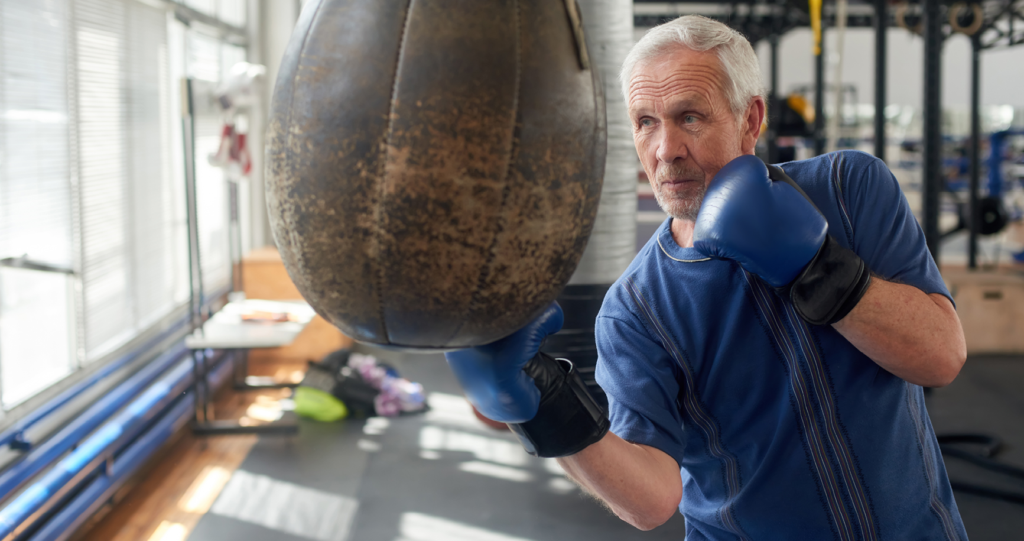
The link between Parkinson’s and boxing: Fighting off symptoms!
Parkinson’s is a neurodegenerative disease characterized by the progressive death of nerve cells in the brain. This disease leads to a variety of symptoms. The most prominent are usually the motor symptoms, including tremors, muscle stiffness, bradykinesia (slowed movements) and balance problems. Physical activity in general can be an effective complementary therapy to improve the quality of life of Parkinson’s patients. Today I asked myself the question: What happens when Parkinson’s and boxing meet in the ring?
Boxing improves motor skills! It requires fast, coordinated movements aimed at improving balance, hand-eye coordination and reaction time. These aspects are often impaired in Parkinson’s patients. Through regular training, sufferers can significantly improve their motor skills, which can lead to a reduction in symptoms such as tremors and muscle stiffness.
Since it is a full-body workout, both strength and endurance can be increased. Parkinson’s patients benefit from strengthening muscles, which helps them to more easily perform everyday tasks and improve mobility. Increasing physical endurance also helps improve overall fitness and reduce the fatigue that often accompanies Parkinson’s.
One of the most promising theories about the benefits of boxing for Parkinson’s patients is, that it promotes neuroplasticity – the brain’s ability to form new neural connections. By learning and repeating new movement patterns during boxing training, patients can potentially slow the progression of the disease and maintain or even improve their neurological function.
Parkinson’s patients often suffer from balance problems and poor posture, which increases the risk of falls. Boxing training involves exercises specifically aimed at improving balance. By practicing evasive maneuvers and stabilizing exercises, patients can improve their stance and posture, leading to better control of their bodies.
In addition to the physical benefits, boxing also has a positive effect on the mental health of Parkinson’s patients. Training can reduce stress, improve mood, and increase self-confidence. Participating in a boxing program, especially in a group, also provides social interaction and support, which promotes general well-being.
Another important aspect is the fun factor. Boxing is a dynamic and challenging sport that gives patients motivation and enjoyment in training. This positive attitude can help patients train longer and more regularly, leading to better results in the long term.
All of these positive effects of boxing for Parkinson’s explain to me why specially developed boxing courses are becoming increasingly popular with Parkinson’s patients. It is important to mention here that you should take part in a boxing course that is specially tailored to patients. These are now increasingly offered either in boxing centres or in specialized clinics for movement disorders. The range of offers is becoming increasingly diverse.
A small addition: Kickboxing
At first glance, kickboxing may seem like an intense sport not suitable for people with Parkinson’s. But this seemingly physically demanding discipline offers a number of benefits that can improve the lives of Parkinson’s patients. Kickboxing combines endurance training, strength, coordination and flexibility – all aspects that play a central role in the treatment of Parkinson’s as already mentioned above.
Also, here it is important that kickboxing training is specifically tailored to the needs of Parkinson’s patients. Therefore, in many cities, sports clubs and clinics are increasingly offering special kickboxing courses for people with Parkinson’s, which take into account the physical limitations of the participants and are accompanied by experienced trainers who are familiar with the specific requirements of the disease.
A project of the Parkinson’s Day Clinic at the University Hospital Hamburg-Eppendorf in Germany, is investigating the effect of targeted kickboxing training on Parkinson’s patients. Since 2022, it has been evaluating whether kickboxing is a treatment option for people with Parkinson’s that finds acceptance among those affected and helps to improve both, physical and psychological impairments caused by Parkinson’s disease. The improvements in posture, gait stability, speech and mood were perceived and described in the participants.
Entering the ring
“Rock Steady Boxing” is a special training concept that was developed in the USA and is specifically tailored to the needs of people with Parkinson’s. It is a contactless fitness training inspired by traditional boxing. However, it is very important to know: You never fight against each other. The only common enemy is Parkinson’s!
The various boxing exercises help people with Parkinson’s to improve their symptoms such as tremors, balance, posture and increase strength and fitness. Courses are offered at four levels, designed for people with Parkinson’s disease, from newly diagnosed to those with advanced disease. Every Parkinson’s patient is welcome: whether they rely on a wheelchair, walker or cane.
Interested participants should first be examined to get the OK from their treating neurologist before attending a relevant course. The boxing course should be tailored to the individual boxer’s abilities, for example based on the Hoehn and Yahr functional levels. (Hoehn and Yahr is a rating scale that assesses the severity of people’s symptoms and the need for support.)
During the first boxing training sessions, the patient should usually first be familiarized with a series of exercises. For example, boxers can do combinations with a speed bag or a heavy bag, train with the trainer or even jump rope. Most courses combine traditional boxing exercises in and outside the ring with strength training, core training, stretching and gymnastics to train the body and mind. The training sessions usually last 75 minutes and include the following elements: warm-up including stretching, coordination training, workout including boxing training, core work (stability training) and a cool down at the end.
My conclusion
For people with Parkinson’s, a program of “jab”, “cross” and “hook” can help ward off symptoms.
Boxing training offers a variety of benefits for Parkinson’s patients beyond the purely physical effects. It is an effective way to relieve symptoms of the disease, improve quality of life and potentially slow the progression of the disease. However, it is important that patients consult with their doctor before starting a boxing training program to ensure that the exercises meet their individual needs and abilities. If the specialist gives the go-ahead for Parkinson’s boxing, it not only offers great exercise, but also camaraderie, hope and joy.
Links:
👉 https://www.parkinsons.org.uk/information-and-support/your-magazine/stories/fighting-back-tommy-talks-fitness-boxing-and-parkinsons (UK)
👉 https://foxrehab.org/parkinsons-disease-symptom-management-rock-steady-boxing/
👉 https://www.parkinsonboxing.nl/; https://www.parkinsonboksennederland.com/diensten (NL)
👉 https://www.aktive-parkinsonstiftung.de/parkinson-informationen/nicht-medikamentoese-behandlung/sporttherapie/boxen/ (GER)
👉 https://www.parkinson.lu/de/leben-parkinson/parkinsons-fighter/stephane-boxing-team (LU)
👉 https://www.parkinson.ch/fr/details/boxe-sans-contact-pour-parkinsoniens (CH)
👉 https://www.aktive-parkinsonstiftung.de/foerdern/gefoerderte-projekte-und-studien/studie-kickboxen-gegen-parkinson/ (GER)
👉 https://hirnstiftung.org/2024/12/maschen-kick-boxen-trotz-parkinson/ (GER)
